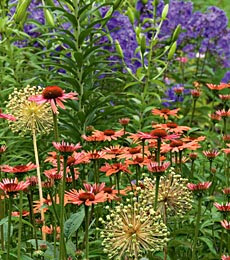Allium is the flower in the hands of a wedding reception. They could become the focus of interest. This interest also can be used as cut flower and decoration flower.
Alliums are also popularly known as garlic. These are very beautiful flowers and very attractive. There are several types of allium. Among them Allium sativum is famous. All the flowers of the allium family (leeks, chives, garlic, garlic (garlic chives)) are edible and have a taste.
The flavor is contained from the leeks and is soft until the garlic is sturdy. All parts of this plant are edible. Allium is a monocot genus of flowering plants, informally referred to as the onion genus. The generic name Allium is the Latin word for garlic.
The genus contains hundreds of distinct species; many have been harvested through human history, but only about a dozen are still economically important today as crops or garden vegetables. Many others are cultivated as ornamental plants.
Allium is taxonomically difficult and species boundaries are unclear. Most authorities accept about 750 species. Estimates of the number of species have been as low as 260, and as high as 860. The type species for the genus is Allium sativum.
Allium species occur in temperate climates of the northern hemisphere, except for a few species occurring in Chile (such as A. juncifolium), Brazil (A. sellovianum) or tropical Africa (A. spathaceum). They can vary in height between 5 cm and 150 cm.
The flowers form an umbel at the top of a leafless stalk. The bulbs vary in size between species, from very small (around 2–3 mm in diameter) to rather large (8–10 cm). Some species (such as Welsh onion, A. fistulosum) develop thickened leaf-bases rather than forming bulbs as such.
Allium is a genus of perennial bulbous plants that produce chemical compounds (mostly cysteine sulfoxide) that give them a characteristic onion or garlic taste and odor.
Many are used as food plants, though not all members of the genus are equally flavorful. In most cases, both bulb and leaves are edible. Their taste may be strong or weaker, depending on the species.
Allium is one of about 57 genera of flowering plants that have more than 500 species. It is by far the largest genus in the Amaryllidaceae, and also in the Alliaceae in classification systems in which that family is recognized as separate.
Allium species are herbaceous perennials with flowers produced on scapes. They grow from solitary or clustered tunicate bulbs and many have an onion odor and taste. Plants are perennialized by bulbs that reform annually from the base of the old bulb, or are produced on the ends of rhizomes or, in a few species, at the ends of stolons.
A small number of species have tuberous roots. The bulbs have outer coats that are commonly brown or grey, with a smooth texture, and are fibrous, or with cellular reticulation. The inner coats of the bulbs are membranous.
Many alliums have basal leaves that commonly wither away from the tips downward before or while the plant flower, but some species have persistent foliage. Plants produce from one to twelve leaves, most species having linear, channeled or flat leaf blades.
The leaf blades are straight or variously coiled, but some species have broad leaves, including A. victorialis and A. tricoccum. The leaves are sessile, and very rarely narrowed into a petiole.
The terete or flattened flowering scapes are normally persistent. The inflorescences are umbels, in which the outside flowers bloom first and flowering progresses to the inside. Some species produce bulbils within the umbels, and in some species the bulbils replace some or all the flowers. The umbels are subtended by noticeable spathe bracts, which are commonly fused and normally have around 3 veins.
The flowers are erect or in some species pendent, having six petal-like tepals produced in two whorls. The flowers have one style and six epipetalous stamens; the anthers and pollen can vary in color depending on the species. The ovaries are superior, and three-lobed with three locules.
The fruits are capsules that open longitudinally along the capsule wall between the partitions of the locule. The seeds are black, and have a rounded shape.
The majority of Allium species are native to the Northern Hemisphere, mainly in Asia. A few species are native to Africa and Central and South America. Species grow in various conditions from dry, well-drained mineral-based soils to moist, organic soils; most grow in sunny locations but a number also grow in forests, or even in swamps / water.


















